Wild leeks are a gourmet’s delight! Hunting wild leeks, and, ultimately, digging them, can be a wonderful outdoor adventure, and a source for some superb eating.
Some readers may be unfamiliar with the term “wild leeks” because in much of this plant’s range, it is known as “ramp.” The wild leek (Allium tricoccum) is found in Iowa, Illinois, and Minnesota, across southern Ontario and Quebec to Nova Scotia. From there it grows in the mountains all the way through New England and New York, to the Mid-Atlantic and all the way to Georgia. In Appalachia, community ramp suppers are common during spring and early summer.
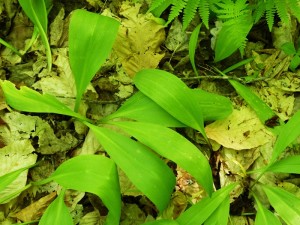
The first step toward a memorable dinner is to get outdoors and go hunting wild leeks in the early spring. Leeks are among the first green plants to emerge in the spring, and that time, before much other greenery shows itself, is by far the best period to go hunting wild leeks. Wild leeks are very easy to identify: they have two bright green leaves that look a good bit like lily of the valley leaves, but have a definite onion odor when crushed.
Hunting wild leeks is best in rich forest soils where deciduous trees (hardwoods) such as sugar maple, yellow birch, beech, ash, black cherry, and similar species make up most of the forest canopy. Take your trekking poles, compass, a GPS if you have one (handy for marking big patches), and begin hiking in promising stretches of forest. Be sure to respect the landowners and stay off posted land unless given permission to be hunting wild leeks on it. The same holds true when digging leeks, as well.
When you have found patches of leeks, be sure to mark the spots so that you can return to them later. A GPS is ideal for this, but a compass bearing combined with pacing or measuring to a readily identifiable point will also work. In familiar local woods you might not have to mark your find at all.
Pinning down the location of leek patches early in the spring is very important to later eating enjoyment, because in only two or three weeks a great many other green plants will have grown up, and the leeks, which stay close to the ground, can be very difficult to spot.
It is best not to dig leeks too early because the bulbs will be very small. The plant apparently stores food in its bulb – then uses some of it in producing flowers and seeds, as well as to grow leaves the following spring. This substantially diminishes the size of the bulbs again. Patience will be rewarded: about three or four weeks after the green leaves grow, the leek bulbs will have doubled or tripled in size, making one’s digging efforts much more rewarding. Be forewarned, however, wild leek bulbs are never very large, and a bulb two-thirds the size of the end of a thumb is a real beauty. Here’s a cautionary note, though. Don’t wait too long, because leek leaves wither and disappear after sending up their flower stalks. This occurs in just another two or three weeks after the ideal digging time. Wait too long and there is no sign that any leeks ever grew there!
We already have several leek patches identified and after waiting (somewhat impatiently) for three or four weeks after emergence of the leaves, it was time to set forth and dig some. And so, on a beautiful day in May in northern Vermont, we set out for what we call The Big Leek Patch, in company with our neighbor, Suzy Graves. We do our serious leek digging in this patch, which is the largest that we’ve ever seen. It’s actually not a solid patch of leeks, but a whole series of interconnected smaller patches that cover most of the ground in an area that must be several acres in size.
Unfortunately, there always seems to be a fly in every ointment, and the fly in the hunting wild leeks ointment happens to be an all-too-real fly, the black fly. The peak of these nasty biting insects happens to coincide with leek season, and the pesky critters abound in the area where we hunt wild leeks. Indeed, Warner often says that we’re the East Coast Distributors for black flies! Edie is particularly bothered by black fly bites, and so she set forth wearing a net bug suit suit from Bug Baffler that covered her from head to toe. If you haven’t tried one of these suits, they can provide complete protection from black flies and mosquitoes for adults and children alike.
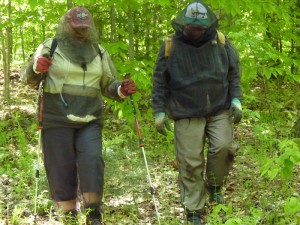
Suzy also had gotten a Bug Baffler suit, and was mightily impressed by their level of service: when she phoned the company at almost the last minute to order the suit, it arrived only a day later, in time for our leek adventure. Warner wore no netting because he is nearly immune to black flies, due to years spent in the woods, where he was bitten copiously. He says that black flies love Edie because she’s so sweet and tender, while they leave his tough, unpleasant-tasting hide alone! Edie agrees completely with this assessment. Suzy’s husband, Goddard, decided not to go with us because he had suffered a lot of black fly bites a few days before, and his arm had gotten badly swollen.
Our path led for nearly a half mile along an old woods road and snowmobile trail that slopes gently to moderately up to the leek patch. The woods were lovely that sunny day, and we thoroughly enjoyed the hike. We were using our Leki trekking poles. We’ve become addicted to them because they’re such a great help. Edie let Suzy try them for a bit, but Suzy felt that we needed them more than she did. However, without them she tripped and fell once and slipped and fell another time. The footing in the woods is often uncertain and trekking poles make a HUGE difference.
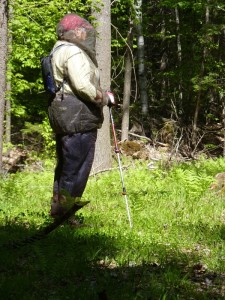
When we arrived at the leek patch, we pulled our camping hand trowels out of our packs. Hand trowels are the one essential item for digging leeks, so don’t skimp when buying one. Loosening the leeks so that they can be pulled or dug out of the ground often requires some fairly heavy-duty prying, and a cheap trowel with a weak handle will soon break off above the blade. Needless to say, our trowels have really strong, durable handles.
Digging leeks without cutting off the bulbs with the trowel requires some practice. Leeks seem to grow at a bit of an angle below ground, so the bulbs often aren’t directly below the stems. Thus, inserting the trowel too close to the stem often results in cutting off the bulb. Instead, insert the trowel several inches away from the stem, push it deep into the ground, and then begin to pry upward. This will usually loosen the leeks so that they can be pulled intact from the ground, or it will bring up a clump of soil with the leeks still embedded in it. A few bulbs will always be accidentally cut off, but a little experience will yield mostly intact leeks.
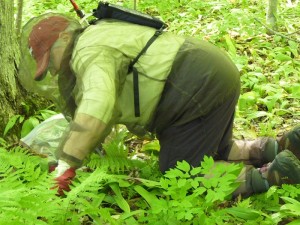
At this point, we began to experience one of those anticipatory moments which makes digging wild leeks so much fun. The aroma of freshly dug wild leeks is potent but heavenly, and in fact the leeks’ odor is considerably stronger than its taste. This aroma certainly enhances your anticipation for the pleasure of eating the leeks!
The digging in The Big Leek Patch is particularly easy. The patch is in a sugar maple grove, where the soil is a rich, black, forest loam. This makes for relatively easy digging, and in an hour’s time we had a fine batch of leeks out of the ground.
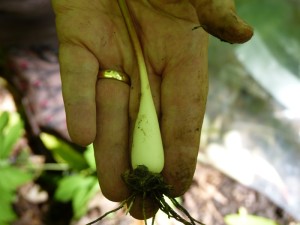
Once the leeks are safely above ground, there are several ways to handle them. They can be put whole in bags or baskets and taken home, where the tops can be used as greens, or chopped and put into such things as soups and stews, much as one would use chives. If the tops aren’t to be used, cut them off above the bulbs with a sharp knife. This is what we usually do. We also prefer at the same time to cut the roots off the bottom of the bulb and clean the worst of the dirt off it. Wild leeks, thus trimmed – even a lot of them – don’t take up much room, so we were able to carry our bounty of trimmed leek bulbs home in a quart plastic freezer bag.
At home, the leeks should be thoroughly washed and rinsed. There is also a very thin, translucent membrane that covers the outside of the bulb, and this can easily be peeled off during the washing process. Once this is done, the great pleasure of eating this wild booty can begin.
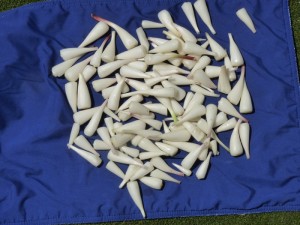
Because wild leek bulbs are so small, we simply use a very sharp knife to cut them crosswise in narrow slices. These slices are small enough so that there is seldom any need to chop the leeks. Once the leeks are sliced, they can be used in many ways. The raw slices make an excellent addition to many salads, ranging from tossed salads to such things as potato salads. This enhances the aroma of the salad and brightens up the flavor considerably. The leek slices also do wonders for the flavor of a wide variety of soups and stews; in this case, the leeks are cooked in the soup or stew. The possibilities for using wild leeks in cooking are innumerable.
Our favorite leek dish, however, is leek quiche, which is truly a gourmet’s delight. We’re going to share the recipe with you, which comes from Gourmet’s Menu Cook Book: a Collection of Epicurean Menus and Recipes a book we highly recommend, published by Gourmet Books, Inc., New York. This recipe, incidentally, was designed to be made with the large domestic leeks of the sort that can be purchased in grocery stores, and it’s delicious when made in its original form.
Because wild leeks are a bit stronger than their domestic cousins, we’ve modified this recipe to use half wild leeks and half domestic ones. This strikes a nice balance in flavor, and requires less of our hard-won wild leeks, but the quiche can certainly be made using only wild leeks.
We have not included the recipe for the crust for three reasons. First, there are plenty of good recipes available for pastry crusts. Second, store-bought crusts have improved mightily and are nearly as good as a good homemade crust – and better than some! Third, we’re happy to make the quiche without any crust; just grease the pan well to avoid sticking.
If you use a crust, it should be partially baked before putting the leek mixture (below) into it. Gourmet recommends 10 minutes in a 400 degree F. oven or until the crust is set but not browned. This may vary a bit with a store-bought crust or some other recipe that you use. The ideal, as stated above, regardless of oven temperature and/or cooking time, is a crust that is set but not browned.
One final word before proceeding to the recipe. Cooked leeks freeze very well and are then available all year for leek quiche or other uses. Because we use 1 ½ cups of sliced wild leeks in a quiche, we cook that quantity in a covered saucepan with 1 ½ tablespoons of butter, ¼ cup of water, and a half teaspoon of salt. Cook over moderate heat for 10 to 12 minutes. Cook until the leeks are soft and the liquid has mostly evaporated. Note: check before the 10 minutes are up to be sure that the liquid hasn’t all evaporated, and keep a close watch. If the heat is just a little bit too high, it’s very easy to burn the leeks in less than the 10-12 minutes.
LEEK QUICHE
In a heavy saucepan melt 3 tablespoons butter and add ½ cup water and 1 teaspoon salt. Add to the pan 3 cups sliced leeks [ 1 ½ cups of wild leeks and 1 ½ cups cultivated leeks], using the white parts only. Cover the pan and cook the mixture over moderate heat for 10 to 12 minutes, or until the pan juices have almost evaporated [see the cautionary note above!]. Lower the heat, cook the leeks until they are soft, and drain them.
Beat together 3 eggs, 1 ½ cups heavy cream, a generous grating of nutmeg, and 1/8 teaspoon pepper. Add the leeks and ¼ cup grated Swiss cheese. [Note: a package of sliced Swiss cheese, such as Kraft’s, will be more than sufficient for both the grated cheese and the cheese triangles in this recipe.] Pour the mixture into the partially baked pastry shell [or the greased pie plate], sprinkle the top with ¼ cup grated Swiss cheese, and arrange thinly sliced triangles of Swiss cheese in a wheel-shaped pattern on the filling.
Dot the top of the quiche with 1 tablespoon butter and bake it in a moderately hot oven (375 degrees F.) for 25 to 30 minutes, or until the pie is puffed and brown.
Now enjoy the fruits of your labors. This quiche will make you want to take up your trekking poles and trowel and sally forth on more leek-digging adventures!



Another favorite use for wild leeks is to do nothing more than simmer them in melted butter until soft, and then use this mixture for pasta sauce. This is particularly wonderful on backpacking trips, since it is quick and easy, and you can steam the tops for your greens. Contrary to what you might reasonably expect, the steamed leek tops are quite sweet!